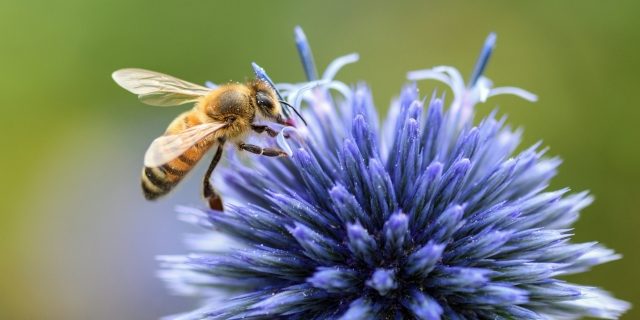11
Nov
Bees Lose Sleep Over Pesticides, Adding Stress and Increasing Risk of Death

(Beyond Pesticides, November 11, 2020) Neonicotinoid insecticides inhibit honey bee sleep cycles, leading to stress and population declines, according to research from Vanderbilt University, published in Scientific Reports. Although there is already ample evidence of the dangers these systemic insecticides pose to pollinators – as evidenced by recent bans in the European Union and Canada – this new line of investigation add further detail to the ongoing crisis in the pollinator world. “I was thinking about honey bee disappearances and it clicked—if pesticides are killing bees indirectly but we don’t know exactly how, maybe it’s because they’re getting physically lost,” said study coauthor Michael Tackenberg, PhD.
Scientists conducted the experiment using honey bees located on Vanderbilt’s campus, which does not use neonicotinoid insecticides. After returning from pollen collection, forager bees were captured at their hive entrance and moved into monitoring tubes, which were subsequently transferred to the lab. In the lab, scientists were able to control light and dark cycles, and exposed bees to levels neonicotinoids they would likely experience if foraging on contaminated flowers.
Foraging bees were first exposed to light/dark at 12/12 cycles, followed by four days of complete darkness, at which time some bees were provided neonics, and others were not. Only 12% of control bees that did not feed on contaminated nectar displayed disrupted sleep cycles, while over 40% of exposed pollinators were adversely affected.
“Graphically, normal circadian rhythms look like steady waves,” said Giannoni-Guzmán, PhD, the paper’s co-first author. “When we observed bees that consumed neonicotinoids over several days, we saw a loss of waves, movement at random times or signs of barely any sleep at all.” Exposed pollinators increased their activity later into the night, although did not display an overall increase in activity.
Researchers were surprised to see that exposing the foragers to consistent darkness, without a light/dark cycle first, appeared to blunt the adverse effects of exposure. This tipped researchers off to the concept that light was playing a key rule in the interplay between neonicotinoids and sleep disruption. Consistent exposure to light disrupted the sleep cycle for 28% of pollinators; when the neonicotinoid thiamethoxam was introduced, a much larger proportion, 46% of bees, were disrupted. In contrast, exposure to the same levels in consistent darkness had no significant effects.
“We have seen how neonicotinoids disrupt honey bees’ biological clocks so that many no longer have regular sleep-wake rhythms,” said study co-author Doug McMahon, PhD. “The bees that do have irregular sleep-wake rhythms are sleep deprived and skewed in their alignment in time and environment.”
Disruption of the circadian clock has far-reaching implications on complex social insects like the honey bee. Many are familiar with the evidence that neonicotinoids disrupt navigation, foraging, memory and learning in exposed bees. Circadian rhythms and sleep patterns support those critical functions. Sleep deprived honey bees are thus more likely to have difficulty returning home after foraging, and remembering or communicating through waggle dance the location of pollen and nectar.
“Beyond sleep disruption, we know that honey bees rely on their internal sense of time and the position of the sun,” said Dr. Tackenberg. “If they have an incorrect sense of time their ability to effectively navigate is hindered. It stands to reason that if a bee’s internal sense of time is disrupted or altered it could affect learning, memory and foraging efficiency—even outside of reduced capacity from sleep disruptions.”
The mechanistic process discovered by researchers has the potential to explain why many beekeepers experience a dwindling or collapsing hive without evidence of other stressors. Foragers that get into a plot of neonicotinoid-contaminated pollen may be cognizant enough at initial stages to communicate the location of this food source to other bees. But over the next several days, more and more bees are likely to become lost on their way home, or worse, reach the hive and potentially undermine the health of the entire colony.
The Saving America’s Pollinators Act would provide pollinators with a real chance to recover from the stressors of pesticide exposure. The bill would eliminate neonicotinoids, other toxic systemics waiting in the wing with the chemical industry, and establish a board of experts to protect pollinator health into the future. Take action today by urging your member of Congress to support this important legislation. You can also get active in your state. Massachusetts residents are encouraged to lend their support to the state’s proposed Pollinator Protect Act, which would eliminate the most toxic neonicotinoids from consumer use. You can also get active in your local community by passing laws that protect pollinator from neonicotinoids and other highly toxic pesticides. If you’re ready to protect pollinators, let us know today that you’ll fight for a pesticide-free community.
All unattributed positions and opinions in this piece are those of Beyond Pesticides.
Source: Vanderbilt University (press release), Scientific Reports










